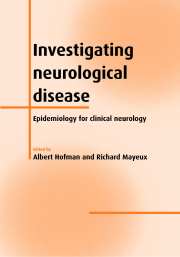Book contents
- Frontmatter
- Contents
- List of contributors
- Preface
- Part I Quantitative methods in clinical neurology
- Part II Neurological diseases
- 10 Cerebrovascular ischemic disease
- 11 Vascular dementia
- 12 Alzheimer's disease
- 13 Parkinson's disease
- 14 Multiple sclerosis
- 15 Myasthenia gravis
- 16 Guillain–Barré syndrome
- 17 Encephalitis and meningitis
- 18 HIV infection
- 19 Prion diseases
- 20 Neoplastic disease
- 21 Cerebral palsy
- 22 Migraine
- Index
10 - Cerebrovascular ischemic disease
from Part II - Neurological diseases
Published online by Cambridge University Press: 29 September 2009
- Frontmatter
- Contents
- List of contributors
- Preface
- Part I Quantitative methods in clinical neurology
- Part II Neurological diseases
- 10 Cerebrovascular ischemic disease
- 11 Vascular dementia
- 12 Alzheimer's disease
- 13 Parkinson's disease
- 14 Multiple sclerosis
- 15 Myasthenia gravis
- 16 Guillain–Barré syndrome
- 17 Encephalitis and meningitis
- 18 HIV infection
- 19 Prion diseases
- 20 Neoplastic disease
- 21 Cerebral palsy
- 22 Migraine
- Index
Summary
Etiology
Magnitude of the problem
Stroke is a major clinical manifestation of atherosclerotic cardiovascular disease along with coronary artery disease (CHD) and peripheral arterial disease. Ischemic cerebrovascular disease accounts for more than 85% of all clinical stroke events with the remainder divided approximately equally between intracerebral hemorrhage (ICH) and subarachnoid hemorrhage (SH). Stroke is the third leading cause of death in most developed countries, accounting for approximately one in 15 deaths. In the United States, nearly 150,000 persons died of stroke in 1995, amounting to one death every 3.4 minutes. Stroke mortality is heterogeneous, is greater among the elderly, in men, and in African–Americans. Even within discrete age and sex groups sizable regional variations in mortality exist between and within nations. In the southeastern United States, stroke death rates are approximately 1.4 times greater than the US average.
Secular trends in mortality
In the United States, death rates from stroke fell steadily at approximately 1% per year from 1915 (when such data became available) until 1968. The pace of decline then accelerated, averaging 5–7% annually; between 1972 and 1990 US death rates from stroke fell a remarkable 65%. This rapid decline more than counter-balanced the aging of the population; as a result, the number of persons dying from stroke also declined steadily. However, the decline in both the numbers and in the age-adjusted death rates for stroke reached a nadir in 1992–1993 and seem to be rising since then for the first time since 1915 (Figure 10.1).
Keywords
- Type
- Chapter
- Information
- Investigating Neurological DiseaseEpidemiology for Clinical Neurology, pp. 137 - 144Publisher: Cambridge University PressPrint publication year: 2001



